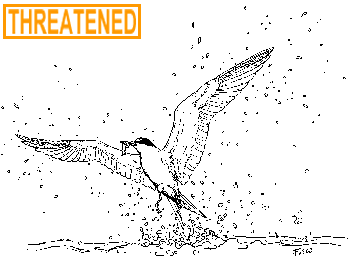Least Tern
Sterna antillarum

Habitat: Broad, sandy, vegetation-free beaches usually located close to an estuary.
Weight: Approximately 1 ounce.
Length: 8.5-9.5 inches.
Wingspan: 20 inches.
Life Expectancy: 15 years of age.
Food: Small fishes, like sandlances; sand eels; crustaceans, like shrimp and prawns.
Status: State threatened.
Identification: The least tern is a small, gull-like bird with long, pointed wings and a forked tail. It is white below and gray above, with black wing tips and a black cap with a white forehead. The bill and feet are yellow. Both sexes are similar; the female is smaller than the male. Least terns have three basic calls: a shrill note, "ky-dik"; a distress call, "oyt"; and a long, complex call used when fishing and for individual recognition.
Range: In the East, least terns nest along the coast from southern Maine to Mexico. There are also populations that nest in the Missouri and Mississippi River systems and on the Pacific coast. The species winters from the Gulf Coast and Central America south to Peru and Brazil.
Reproduction: Least terns arrive in Connecticut in early May and quickly form pairs that last the whole season. In mid-May, the first eggs are laid in a shallow depression in the sand. A nest consists of 1 to 3 cream-colored eggs with dark brown blotches. The eggs hatch in 21 days and the downy young are out of the nest by the second day. About 21 days later, the young are able to fly but continue to be fed by the adults into the migration period. Two years elapse before the young mature and begin to breed. If a nest is destroyed or the young die at an early age, the adults are able to produce a new clutch in 6 to 10 days.
Reason for Decline: By the early 1900s, this species was almost extinct because of market hunting for the millinery trade. Although least tern numbers have rebounded, today the development of the shoreline for recreation has limited the number of available nest sites. In addition, beach stabilization projects have reduced the quality of the remaining sites, forcing the birds to nest in areas with greater vegetation and increased human disturbances. Vegetation provides cover for, and human activities encourage the presence of, predators such as dogs, cats, rats, skunks and raccoons. In addition, human disturbances affect productivity by keeping birds off nests, thus preventing them from properly incubating eggs or attending young. Outright destruction of nests is also a factor.
History in Connecticut: Historically, the species has been declining in Connecticut due to residential and recreational development of beaches and the channelization of rivers. Heavy losses are also caused by severe storms, flooding, and depredation by dogs, cats, rats, skunks, raccoons, black-crowned night-herons and great black-backed gulls. Recent protection measures in the Northeast, which include the fencing and posting of colonies, may have stabilized the population.
In Connecticut, least terns often share their nesting areas with the federally and state threatened piping plover. Since 1987, least terns have nested at 15 sites along the Connecticut coast from Greenwich to Groton.
Interesting Facts: The defense mechanism of adult terns when intruders enter the nesting area is to divebomb and defecate on the offender. This style of attack led them to be called "little striker." The chicks freeze to avoid detection.
Least terns get small fishes and crustaceans by skimming the surface of the water or by hovering, then diving into the water. They catch their prey in their bills.
The West Coast and interior populations of least terns were classified as federally endangered as early as 1970.
Terns respond to shifting beach conditions caused by sand deposition or increased vegetation by changing nest sites as the levels of habitat quality and predation change. In a given region, only a portion of the available habitat is used, thus allowing the number of birds to vary from year to year but keeping the region-wide population stable. The tendency to renest when nesting is disrupted and the longevity of adult least terns are additional adaptations to the unstable beach environment. A survival rate of 10 to 20 percent of their young is acceptable for maintaining a stable population, and 1 or 2 years of low productivity can be offset by subsequent years of high productivity. However, low productivity over a 5 to 10 year period could pose a major threat to the population.
Protective Legislation: Federal - Migratory Bird Treaty Act of 1918. State - Connecticut General Statutes Sec. 26-311.
What You Can Do: Respect all least tern nesting areas that are fenced or posted for the birds' protection. Do not approach or linger near least terns or their nests. If pets are permitted on beaches used by terns, keep pets on a leash. Keep housecats in the house, especially at night, during the nesting season. Don't leave or bury trash or food scraps on beaches. Garbage attracts predators which may prey upon least tern eggs and chicks.

The production of this Endangered and Threatened Species Fact Sheet
Series is made possible by donations to the Endangered Species/Wildlife Income Tax
Checkoff Fund.
(rev. 12/99)

